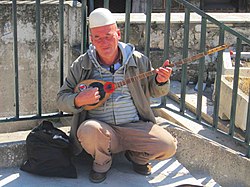Top Qs
Timeline
Chat
Perspective
Çifteli
Plucked string instrument with only two strings From Wikipedia, the free encyclopedia
Remove ads
The çifteli, çiftetelli saz (Turkish: 'doubled', 'double stringed saz', Albanian: çiftelia, qifteli) is a plucked string instrument, with only two strings, played in the Balkans and Thrace but mainly in the Albania, Montenegro, North Macedonia, Kosovo, Greece, Bulgaria and Turkey.[1]

The çifteli is a common folk instrument played in weddings and at concerts similar to the related instruments like bağlama or cura. It is mainly used in folk music (in particular Albanian folk music) as well as in various musical styles such as the performances of Nikollë Nikprelaj. It is also used to accompany Albanian epics and ballads.[2]
Remove ads
Construction
Çifteli vary in size, but are most often tuned to B3 and E4 (comparable to the top two strings of a guitar, which is classically tuned as "E2 A2 D3 G3 B3 E4"). Usually the lower string is played as a drone, with the melody played on the higher string.[3] The çifteli is a fretted instrument, but unlike most, it is not fretted in a chromatic scale (one fret per semitone), but rather in a diatonic scale, with seven notes to the octave.
The çifteli is a microtonal instrument, with makam Hüseyni being used on some çiftelis.[4]
Remove ads
Etymology
The term çifteli and çiftetelli are derived from Turkish çift ('double')[5] and tel ('wire', 'string'),[6] with the Turkish suffix -li ('with'),[7] so çiftetelli means 'with doubled strings', it takes the name from the number of strings used.[8][9][10][11]
History
Being a Balkan folk instrument the çifteli originates from Balkan peninsula particularly from Albanian speaking territories.[citation needed] The instrument delivers a unique melody, sound and also acts as accompany instrument to singing.[12] The çifteli is closely related and similar to other common stringed instruments like the bağlama, cura, balkan tambura in many aspects but has its unique sound and character. It is also can be regarded as unique instrument rather than a modification or a derivative of common stringed instruments.[citation needed]
See also
References
Wikiwand - on
Seamless Wikipedia browsing. On steroids.
Remove ads

